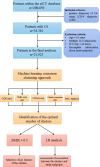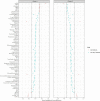Identification of distinct clinical phenotypes of cardiogenic shock using machine learning consensus clustering approach
- PMID: 37644414
- PMCID: PMC10466857
- DOI: 10.1186/s12872-023-03380-y
Identification of distinct clinical phenotypes of cardiogenic shock using machine learning consensus clustering approach
Abstract
Background: Cardiogenic shock (CS) is a complex state with many underlying causes and associated outcomes. It is still difficult to differentiate between various CS phenotypes. We investigated if the CS phenotypes with distinctive clinical profiles and prognoses might be found using the machine learning (ML) consensus clustering approach.
Methods: The current study included patients who were diagnosed with CS at the time of admission from the electronic ICU (eICU) Collaborative Research Database. Among 21,925 patients with CS, an unsupervised ML consensus clustering analysis was conducted. The optimal number of clusters was identified by means of the consensus matrix (CM) heat map, cumulative distribution function (CDF), cluster-consensus plots, and the proportion of ambiguously clustered pairs (PAC) analysis. We calculated the standardized mean difference (SMD) of each variable and used the cutoff of ± 0.3 to identify each cluster's key features. We examined the relationship between the phenotypes and several clinical endpoints utilizing logistic regression (LR) analysis.
Results: The consensus cluster analysis identified two clusters (Cluster 1: n = 9,848; Cluster 2: n = 12,077). The key features of patients in Cluster 1, compared with Cluster 2, included: lower blood pressure, lower eGFR (estimated glomerular filtration rate), higher BUN (blood urea nitrogen), higher creatinine, lower albumin, higher potassium, lower bicarbonate, lower red blood cell (RBC), higher red blood cell distribution width (RDW), higher SOFA score, higher APS III score, and higher APACHE IV score on admission. The results of LR analysis showed that the Cluster 2 was associated with lower in-hospital mortality (odds ratio [OR]: 0.374; 95% confidence interval [CI]: 0.347-0.402; P < 0.001), ICU mortality (OR: 0.349; 95% CI: 0.318-0.382; P < 0.001), and the incidence of acute kidney injury (AKI) after admission (OR: 0.478; 95% CI: 0.452-0.505; P < 0.001).
Conclusions: ML consensus clustering analysis synthesized the pattern of clinical and laboratory data to reveal distinct CS phenotypes with different clinical outcomes.
Keywords: Acute kidney injury; Artificial intelligence; Cardiogenic shock; Cluster; Intensive care unit; Machine learning; Mortality; Phenotype.
© 2023. BioMed Central Ltd., part of Springer Nature.
Conflict of interest statement
The authors declare that they have no competing interests.
Figures





References
-
- van Diepen S, Katz JN, Albert NM, Henry TD, Jacobs AK, Kapur NK, Kilic A, Menon V, Ohman EM, Sweitzer NK, et al. Contemporary Management of cardiogenic shock: a Scientific Statement from the American Heart Association. Circulation. 2017;136(16):e232–68. - PubMed
Publication types
MeSH terms
LinkOut - more resources
Full Text Sources
Research Materials
Miscellaneous

